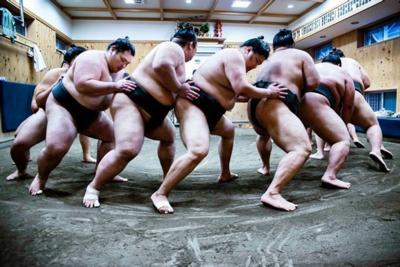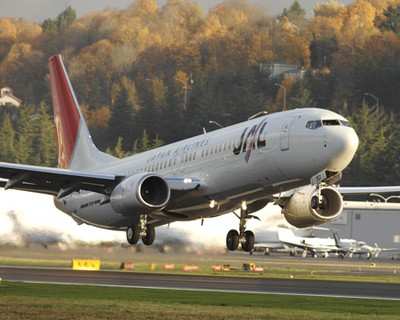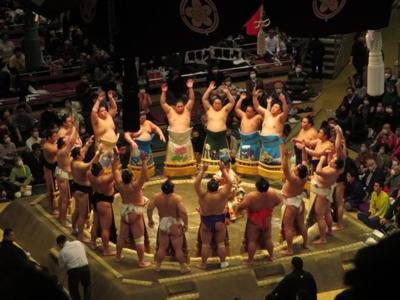Shiko Your Booty; or, It All Comes Out In the Mawashi
Japanese flagship air-carrier Japan Airlines (JAL) recently found itself uncomfortably middled between national pride and the immutable principles of physics to which aircraft operations are immutably beholden.

On 12 October, JAL was forced to add an extra domestic flight for purpose of accommodating a sizable group of sumo wrestlers traveling to attend the Special National Sports Festival on Amami Oshima Island in Japan’s southern Kagoshima Prefecture.
All told, 27 wrestlers, known in Japanese as rikishi, a term translating, more or less, to men of strength, had been booked to travel in two groups aboard a pair of JAL Boeing 737-800s—narrow-body jets with cabin capacities of roughly 165 passengers.
One group, consisting of 13 rikishi, was booked to depart Tokyo’s Haneda International Airport (HND); the remaining 14 wrestlers were to start their collective journey to Amami Oshima Island from Osaka’s Itami Airport (ITM), some 217-nautical-miles southwest of Tokyo.
While the individual’s identity remains unknown, a perspicacious JAL employee arrived at the realization that sumo-wrestlers, the most massive of whom top six-hundred-pounds, handily exceed the 154.3-pound average weight the air-carrier ascribes to its passengers. While Boeing’s 737-800 is, in fact, capable of accommodating a good many sumo wrestlers, the aircraft must also carry a great deal of fuel. As the flight from HND to ITM spans approximately 682-nautical-miles, concerns arose in JAL’s operations division that the combined mass and distribution of the wrestlers and the requisite jet fuel would fall outside the 737-800’s weight-and-balance envelope.

Resorting to mathematics, JAL Ops hastily calculated the 27 sumo wrestlers weighed an average of 264.5-pounds. So enlightened, the division’s resident boffins set about determining whether or not the two planned flights were feasible.
In short-order, however, another keen-minded JAL employee concluded the 6,562-foot runway at Amami Oshima Island’s Amami Airport (ASJ) was too short to safely and legally accommodate fully-loaded 737-800 aircraft.
Moment by moment, complication by complication, the wrestlers’ travel plans slipped ever nearer abject impracticability.
Undeterred, the clever types with which JAL is staffed to the taruki devised an impromptu-but-elegant workaround. The airline mustered its considerable resources and added a special flight to its 12 October schedule—a flight devoted solely to delivering the 27 rikishi to the island sports festival.
By way of logistics, the 14 wrestlers slated to depart ITM were first ferried to HND, where they enplaned the special flight along with their 13 colleagues. Thereafter, the entire group enjoyed a unified and uneventful passage to ASJ.
A JAL spokesman set forth it was “extremely unusual” for the airline to “operate special flights due to the weight restrictions on this [737-800] aircraft.”

The sumo wrestlers were returned home by dint of an identical, if not inverse scheme.
Japan’s national sport, Sumo, a term meaning striking one another, is a form of competitive, full-contact wrestling in which contestants attempt to force each other either out of a circular ring known as a dohy?, or into touching the ground with any body-part other than the soles of the feet. This is accomplished by pushing, pulling, throwing, or any of an assortment of alternate, sanctioned means of manhandling.
Though potentially prestigious and profitable, life as a sumo wrestler is highly regimented and governed by strict rules implemented by the Japan Sumo Association. Most sumo wrestlers are required to live in communal sumo training stables known in Japanese as heya, in which all aspects of daily life—from meals to manner of dress—are dictated by strict kyara tradition.
 Aero-TV: DeltaHawks Diesel Power Steps Into the Spotlight
Aero-TV: DeltaHawks Diesel Power Steps Into the Spotlight NTSB Prelim: Mooney Aircraft Corp. M20K
NTSB Prelim: Mooney Aircraft Corp. M20K ANN FAQ: Turn On Post Notifications
ANN FAQ: Turn On Post Notifications ANN's Daily Aero-Linx (12.20.25)
ANN's Daily Aero-Linx (12.20.25) Aero-News: Quote of the Day (12.20.25)
Aero-News: Quote of the Day (12.20.25)





